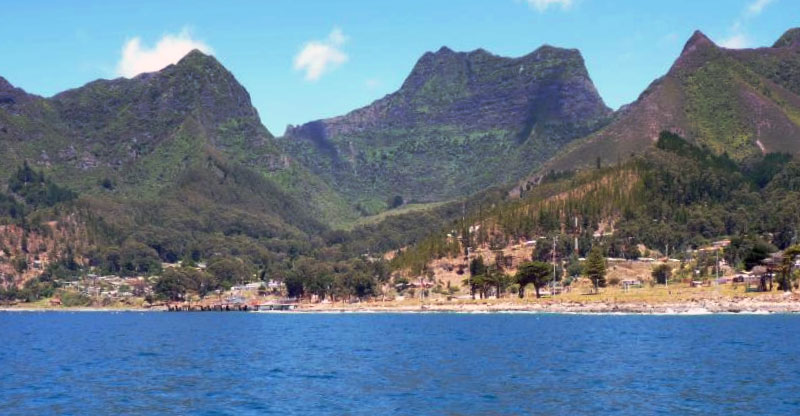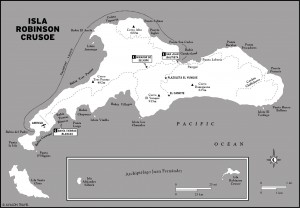
View of Isla Robinson Crusoe taken in 2011 (one year after the tsunami which hit its shores.) Photo © Pato Novoa, licensed Creative Commons Attribution.
All of Isla’s Robinson Crusoe’s 700 or so inhabitants live in or near the village of San Juan Bautista. Nearly all of them depend directly or indirectly on fishing for the so-called Juan Fernández lobster, in reality a crayfish, and on the modest tourist trade. Both of these are seasonal activities, from October to April or May; the tourist season peaks in January and February.Though still one of Chile’s most isolated settlements, San Juan Bautista has modern infrastructure, with comfortable guesthouses, a state-of-the-art phone system, satellite TV, and even roads capable of handling an increasing fleet of motor vehicles—in a town where it’s impossible to work up enough speed to get out of second gear. For all of this, few islanders visit the “continent” except for education or medical emergencies; even then, Chile’s air force pays literal “flying visits” to deal with routine medical and dental care on the island’s airstrip.
The outstanding contemporary travel essayist Thurston Clarke describes San Juan, its people, and surroundings in the opening chapter of his Searching for Crusoe: A Journey Among the Last Real Islands (Ballantine, 2001).

Isla Robinson Crusoe
On Robinson Crusoe’s well-watered north shore, at the foot of the precipitous Cordón Chifladores, San Juan Bautista sits on a narrow wave-cut terrace facing the sheltered Bahía Cumberland. One curving main street, Larraín Alcalde, runs nearly the length of the village; toward its south end it becomes the pedestrian Costanera El Palillo. Other streets, and footpaths, rise at right angles from Larraín Alcalde. Since the 2010 tsunami, most construction has moved inland and uphill.
Launches to and from the airfield at Bahía del Padre use the Embarcadero immediately east of the plaza. There is also a ramp for the Chilean navy’s roll-on, roll-off cargo ferry a short distance to the south.
Best known as the site of Selkirk’s solitary exile, San Juan is home to several historical landmarks, all just a short distance from the plaza.
In 1749, alarmed that British privateer Lord Anson had spent three months at Bahía Cumberland preparing to attack the ports of El Callao (Peru), Acapulco (Mexico), and Manila (Philippines), Spain tried to discourage incursions by sending 200 colonists to the island. Less than two years later, a tsunami destroyed the settlement, but in 1770 the Spanish crown sent engineer José Antonio Birt to plan the fortifications of Fuerte Santa Bárbara, with mortar-covered stone walls and gun emplacements with several cannon each. Partially dismantled in 1817, then damaged by earthquakes in 1822 and 1835, the fortress was reconstructed in 1974.
After Chilean rebels suffered the so-called “Desastre de Rancagua” in 1814, Spanish commander Mariano Osorio raided the homes of 42 key figures who, first transported to Valparaíso, were then shipped to Masatierra aboard the corvette Sebastiana. Juan Egaña, Manuel de Salas, U.S. consul Matthew Arnold Hoevel, and the others spent three years in the damp grottos now known as the Cuevas de los Patriotas, now a national monument, before the ultimate Chilean victory freed them.
The 2010 tsunami flattened the German headstones at Cementerio San Juan Bautista, presently under reconstruction near the lighthouse at the north end of town. The graveyard still recalls the World War I odyssey of the German cruiser Dresden, which lies beneath the offshore waters where fur seals now cavort (British shells that missed their target are embedded in nearby headlands). Other gravestones bore mostly Spanish but also French inscriptions from the islands’ colonists.
Vivero Conaf (at the top of Vicente González, open for tours on request) is a nursery that grows native species for reforesting the park and ecological exotics for planting near the village. Two invernaderos (greenhouses) nurture the seedlings.
San Juan Bautista also has a handful of B&B accommodations that consistently serve local lobster for dinner. Since accommodations are limited, reservations are important in January and February. Nowhere except perhaps Pangal will visitors be able to avoid barking dogs at night.
Uphill from a point just north of the Embarcadero, Residencial Barón de Rodt (La Pólvora s/n, tel. 032/2751109, [email protected], US$40 pp) has just two double rooms, so reservations are almost essential. Its tobacco-free restaurant prepares superb fish and other dishes at reasonable prices.
Just uphill from Fuerte Santa Bárbara, Residencial Mirador de Selkirk (El Castillo 251, tel. 032/2751028, [email protected], US$70 pp with full board) is an attractive three-room B&B (shared bath only) that’s also one of the best places to eat: Fish doesn’t get any fresher, nor any better prepared, than it does here. The deck has ocean views.
Directly across from the police station, run by an ex-Carabinero, Hostal Petit Breuilh (Vicente González 84, tel. 032/2751107, US$45 s, US$72 d with breakfast; US$54 s, US$100 d with half board; US$70 s, US$120 d with full board) is another good choice. The first night’s dinner includes lobster. Some suggest, though, that its recent expansion has focused on quantity before quality.
On the waterfront footpath to El Palillo, the recently reopened, tobacco-free Refugio Náutico (Ignacio Carrera Pinto s/n, tel. 032/2751077, US$110 s, US$200 d with breakfast) also has full- and half-board rates and multi-day packages that include activities.
Reached by a shuttle launch from the Embarcadero or a scenic 45-minute hike that switchbacks up the slope from El Palillo before following the road the rest of the way, Crusoe Island Lodge (tel. 02/4326800 in Santiago, 144–377 s, US$240–488 d with breakfast) has reinvented itself as an isolated spa hotel that emphasizes all-inclusive activities packages, but will take overnighters for accommodations only.
About 500 meters uphill from the shoreline, Conaf’s Centro de Información Ambiental Eduardo Paredes (Vicente González 130, tel. 032/2751004 or 032/2751022, 8 a.m.– 12:50 p.m. and 2–6 p.m. Mon.–Thurs., closes 10 minutes earlier on Fri.) is the visitor center for Parque Nacional Juan Fernández. It has professional displays on the park’s geography, environment, and history, including topics such as the endangered fur seal and the scuttled Dresden. Built and organized with Dutch assistance, its English is as good as its Spanish. When the tourist presence is heavy, it may be open on weekends.
Bring money from the continent, in small bills. San Juan has no exchange facilities, relatively little cash circulates, and shopkeepers have trouble making change. Accommodations normally accept U.S. dollars, but credit cards are nearly useless.
Since the tsunami, Correos de Chile, the post office, has relocated up the hill toward the Cuevas de los Patriotas.
For medical treatment, the only option is the government-run Posta Rural (Vicente González s/n, tel. 032/2751067).
For most visitors, air taxis from Santiago are the only practicable means of transportation, but for those with plenty of time or particularly good timing, sea travel from Valparaíso is conceivable.
Two companies provide air-taxi service from Santiago; flights are frequent in January and February, few outside the November to March period, and windy or rainy weather can abort takeoffs and landings at any time of year. Visitors should arrange their itineraries and finances to be able to stay a day or two extra in case of adverse weather. Round-trip fares are about US$1,100, but it doesn’t take a lot of negotiating to get a 20 percent discount.
Many carriers have come and gone, but Lassa (Av. Larraín 7941, La Reina, tel. 02/2735209 or 02/2731458, [email protected]; Alcalde Larraín s/n, San Juan Bautista) has shown the greatest durability and reliability. It flies out of Aeródromo Tobalaba, in Santiago’s eastern suburbs; its Piper Cheyennes carry a maximum of six passengers. Aerolíneas ATA (tel. 02/2343388) also flies out of Tobalaba.
San Juan Bautista is about 1.5 hours by motor launch from the passenger pier at Bahía del Padre, an ocean-flooded caldera reached by a short but precipitous dirt road from the renovated airfield, which occupies one of few relatively level sites on the entire island (and now has toilets as well). The boat transfer, usually included in the air ticket, is scenic, but the seas can be rough on visitors unaccustomed to relatively small ships; consider medication.
Sailing from Valparaíso to Juan Fernández requires patience and good timing. Transmarko (Esmeralda 940, 11th Fl., Oficina 111-A, tel. 09/6157-7480, [email protected]) makes a monthly no-fixed-date voyage from Valparaíso (from the continent to the island: US$212 non-residents, US$320 roundtrip; 40 hours) on the M/N Antonio, which can carry 12 passengers.
From September to May, Transmarko also carries passengers to Isla Alejandro Selkirk (US$60 pp) on a space available basis, but lobster fishermen and their families have priority.
Walking is the best way to get around San Juan and most of the national park, but some sights are most easily accessible by launch. Ask at the Municipalidad, around the Embarcadero, or your accommodations may be able to arrange something. The Municipalidad maintains a list of prices for launch excursions around the island.
Endémica Expediciones (tel. 032/2751227) has a dive center here; most sites are on the island’s north side.
Excerpted from the Fourth Edition of Moon Chile.